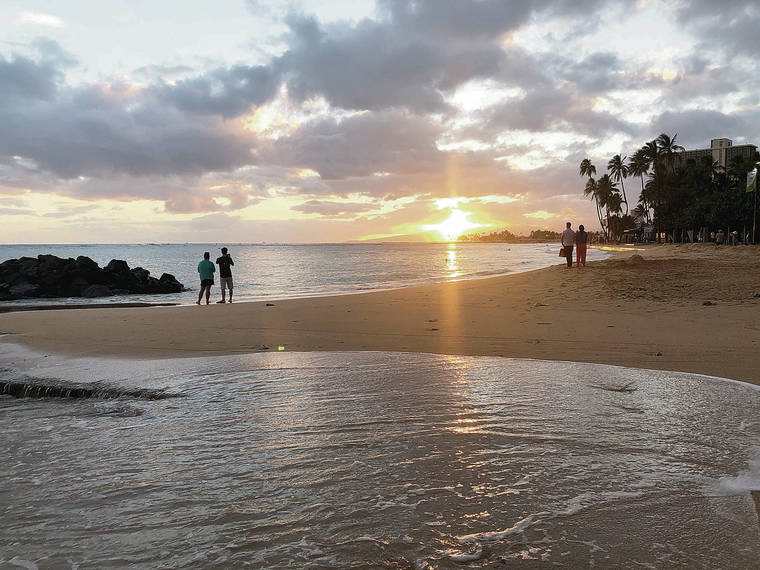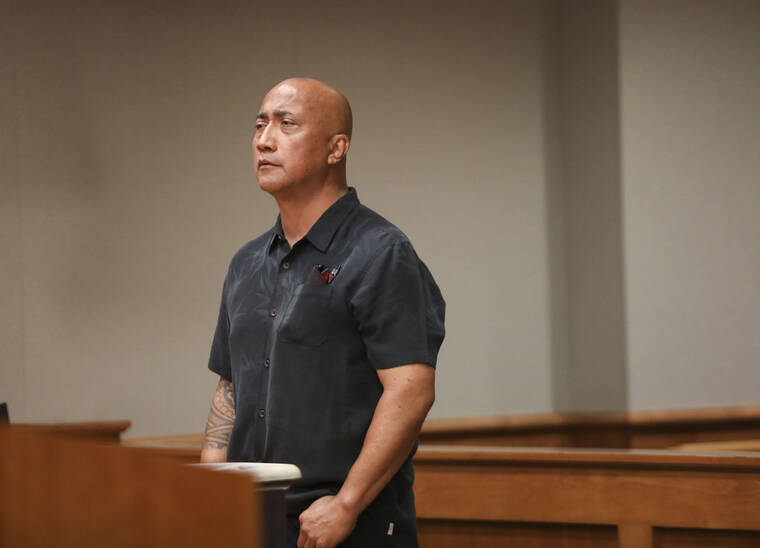Demand for travel could boost Hawaii’s recovery

GEORGE F. LEE / GLEE@STARADVERTISER.COM
Gov. David Ige has not set an official date to lift the mandatory 14-day quarantine for trans-Pacific travel. Visitors to Waikiki Beach were sparse at sunset earlier this month.
Out-of-state travel demand for Hawaii is building as the nation and other countries begin reopening.
Hawaii visitor industry members say there’s still time to recapture part of Hawaii’s peak summer travel season if Gov. David Ige makes a definitive announcement soon that he’s willing to ease restrictions in August for travelers with negative COVID-19 Opens in a new tab tests.
But that’s a big if.
The window for Hawaii to get a piece of the summer action is narrowing as other major destinations, including Mexico and the Caribbean, reopen. Even cautious destinations like Alaska and Tahiti have begun to lap Hawaii by adopting testing protocols that ease restrictions for travelers with negative COVID-19 tests at a time when the state’s out-of-state tourism reopening plans aren’t even out of the starting block.
On Tuesday, Hawaii lifted its mandatory 14-day self-quarantine for interisland passengers. Preliminary feedback shows using tougher screening, including a travel declaration form and thermal screening, to reopen Hawaii’s inner borders began smoothly.
That’s good news, but increased interisland travel isn’t expected to bolster Hawaii’s beleaguered visitor industry much. On Tuesday, only 445 out-of-state visitors were among the 1,671 passengers that came into Hawaii. That’s down from June 2019, when daily passenger counts averaged 35,000 a day.
Don't miss out on what's happening!
Stay in touch with breaking news, as it happens, conveniently in your email inbox. It's FREE!
Tourism leaders are hoping the reopening of interisland travel will reassure government officials and the community that restarting out-of-state travel is safe as well. Hawaii’s government leaders have the complicated job of balancing the need to use tourism to jump-start Hawaii’s critically weakened economy against the desire to keep COVID-19 cases and deaths low.
No date for reopening
So far Ige hasn’t picked an official date to begin the recovery of trans-Pacific tourism, which brought the bulk of the 10.4 million visitors who contributed nearly $18 billion in spending to the state’s economy in 2019. On Monday, he hinted that a restart could come as early as August. However, Ige stopped short of setting a date.
“Certainly, we are going to allow it when we feel that it’s safe for our community. The general quarantine will probably be the last thing lifted, because we still see virus outbreaks,” Ige said Monday during a Honolulu Star-Advertiser COVID-19 Care Conversation.
There are rumors that Ige could announce a date this week. A hui led by Lt. Gov. Josh Green is working to get his approval for a plan that gives passengers the option of bypassing the quarantine if they take a COVID-19 test within 72 hours of coming to Hawaii and produce negative results upon entry.
Ige said Monday that he is talking with national drugstores and pharmacies about the possibility that they might administer COVID-19 tests without a doctor’s order or prescription. Passengers that arrive in Hawaii without test results would be given the option of taking the test in Hawaii and quarantining until they got a negative result.
Jack Richards, president and CEO of travel wholesaler Pleasant Holidays, said the testing plan adds “cost and complexity” to a trip to Hawaii, but is more favorable than delaying reopening any longer. Based on Pleasant’s experience with COVID-19 travel testing programs in Tahiti and Alaska, Richards recommends lengthening the testing window to 96 hours.
“I’m worried as more destinations start to use testing that there’ll be a backlog,” Richards said. “I think we also need to address what happens when a traveler gets a positive result. If they can’t postpone travel or get a refund, they won’t want to risk paying thousands of dollars for a Hawaii trip.”
Postponements and cancellations due to constant out-of-state quarantine extensions already have interfered with Hawaii’s travel recovery at a time when pent-up travel demand is emerging, Richards said.
Indeed, Southwest Airlines was expected to restore it’s interisland and mainland service in Hawaii to pre-COVID levels on July 1 but Wednesday pushed it back to Aug.1 along with the launch of its San Diego to Honolulu service. Southwest’s July schedule will look just like its June schedule.
“There’s still time to try to rebook customers who were planning to travel to Hawaii before July 31 if we get a confirmed reopening date,” Richards said. “Hawaii is a mostly family leisure travel market so most will want to rebook for summer travel. If they can’t, we’ve probably lost that reservation for this year.”
Richards said it’s hard to sell travel to Hawaii or put money into marketing without an official reopening date.
“We’ve seen an increase in Tahiti business for 2020 and 2021, but Hawaii is still down,” he said. “Mexico has now reopened and most of the Caribbean — these are some of Hawaii’s main competitors.”
Positive signs
The good news is there are signs that American consumers are traveling again and Hawaii still might be able to get in on some of the action.
Chris Kam, Omnitrak president, said preliminary results from the company’s June 5 to June 17 survey of 2,500 U.S. travelers shows that people have not increased their intent to take a trip but there was a big increase in the likelihood that they would travel.
“While people are not actually booking trips, the interest and desire to book a trip have started rise,” Kam said. “People are still in wait and see mode but that interest in travel is encouraging.”
Brad DiFiore, Ailevon Pacific Aviation Consulting managing director, recently said at a Pacific Asia Travel Association of Hawaii economic forum that “Hawaii is a top choice for travelers’ next trip.”
Only Florida, California, Nevada, Texas and North Carolina scored higher in the survey of 772 people with plans to travel in 2020, DiFiore said.
DiFiore’s air outlook for 2020 shows that domestic travel will drive Hawaii’s initial recovery, which will not occur until the quarantine is eliminated.
DiFiore said restoration of Hawaii’s harder-hit international air service won’t happen until quarantines are eliminated at both ends. Currently all foreign countries are requiring 14-day quarantines upon return from the U.S., he said.
Ige said the state is pursuing travel agreements that would ease restrictions into Hawaii for countries like Japan, South Korea, Australia and New Zealand where COVID-19 cases and deaths have been low.
DiFiore said return of visitor confidence in the safety of the destination must happen before international service is restored to Hawaii.
He expects Hawaii’s domestic recovery will start in West Coast markets and a handful of interior hub markets. Hawaiian Airlines, Southwest Airlines and Alaska Airlines will reinstate service faster than network carriers, he said.
Indeed, Southwest Wednesday informed shareholders and the Securities and Exchange Commission that trends were “modestly improving” for factors like revenue, load, cash burn, cash balance, and months of liquidity. The improvements from last month are off a small base of operation.
Southwest spokesman Brad Hawkins said “the improvements in demand continue to be leisure-driven and in areas such as beaches, mountains, desert, nature-inspired destinations; business demand still lags, and we expect a gradual return of business and international travel.”
Southwest reported in its shareholder and SEC filing that operating revenues are trending up from April, when it was down 90% to 95% year-over-year. May operating revenues were down 85% to 90%; June is estimated to be down 70% to 75% and July 65% to 70%.
The carrier reported planes were 8% loaded in April and 30% loaded in May. They are estimated to be in the 40% to 50% range in June and in the 45% to 55% range in July.
Improving revenue trends have reduced Southwest’s second quarter core cash burn to the $20-$25 million range from last month’s estimated $25 million. June’s core cash burn is now expected to be $20 million, up from the low $20 million range.
“We are encouraged by recent trends, but we can’t be happy with revenue declines of this magnitude,” Hawkins said.




